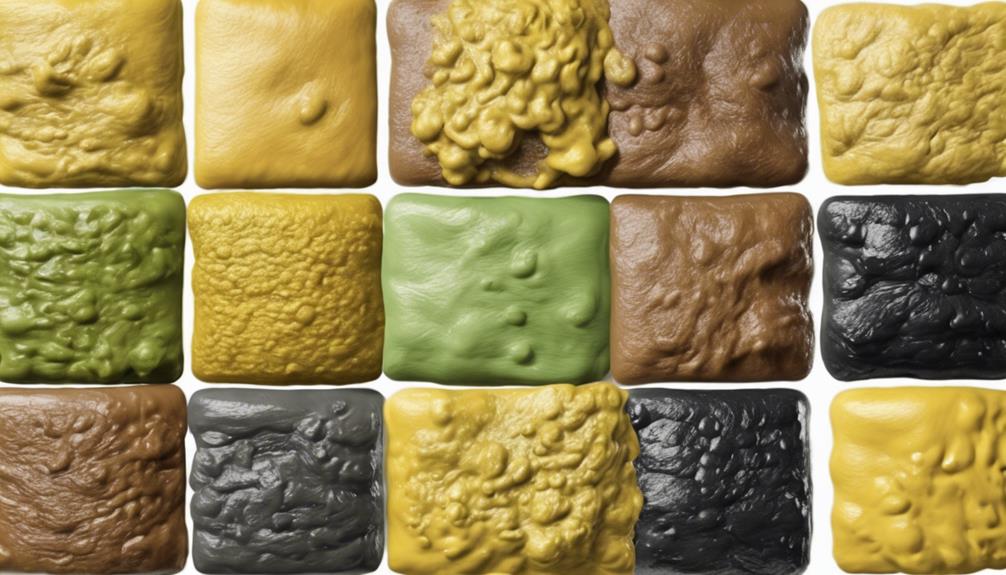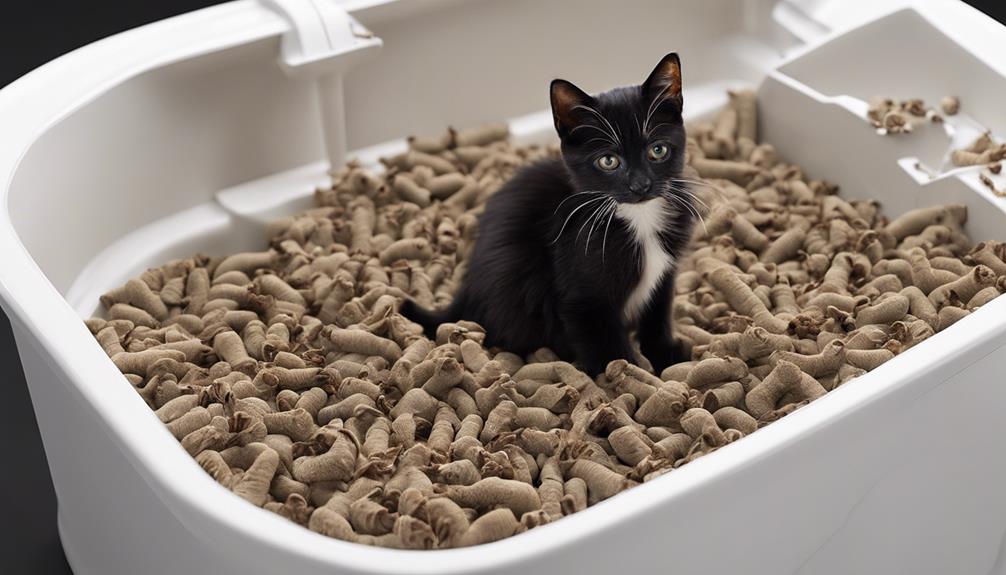As parents, we've all been there – the mysterious world of newborn poop. The color, the texture, the surprises it can hold. But fear not, understanding what's going on in your little one's diaper is important for their well-being.
From the initial black meconium to the eventual shift to a different shade, deciphering these clues is like decoding a secret message. So, let's unravel the mysteries together and guarantee your baby's digestive health is on track.
Key Takeaways
- Meconium is dark greenish-black, transitioning to yellow or green in healthy newborns.
- Texture varies from sticky/tarry (meconium) to seedy (breastfed) or pasty (formula-fed).
- Changes in color, texture, and smell indicate digestive health and development.
- Red, black, white, or mucus-containing stools require medical attention for potential issues.
Types of Newborn Poop Colors
What colors can newborn poop come in and what do they signify about the baby's health?
The color of a baby's poop can provide valuable insight into their well-being. Initially, meconium, the baby's first stool, is dark greenish-black due to the presence of amniotic fluid, mucus, and skin cells. As babies shift to breast milk, their poop typically changes to a mustard yellow or yellow-green color. Breastfed babies often have softer, more liquid stools compared to formula-fed babies, whose poop may be firmer and lighter in color.
Observing variations in newborn poop colors is essential as it can indicate digestive changes or potential health issues. For instance, red poop may suggest blood in the stool, while black, white, or grey colors could signal specific health concerns that require medical attention. By monitoring their baby's poop colors, parents can track their digestive health and promptly address any arising problems. Remember, a baby's poop color can reveal a lot about their health, so staying informed and observant is key to ensuring their well-being.
Newborn Poop Texture Variations

Understanding the variations in newborn poop texture provides valuable insights into their digestive health and well-being. Here's what you need to know:
- Meconium: Newborns typically pass sticky and tarry meconium in the first days, consisting of mucus, amniotic fluid, and dead cells.
- Breastfed Babies: Breastfed newborn poop evolves from greenish-black meconium to yellowish-green with a seedy consistency, resembling mustard or cottage cheese.
- Formula-Fed Babies: Formula-fed newborn poop may appear thicker and pastier, akin to peanut butter or pudding in texture.
- Monitoring Health: Keeping an eye on your newborn's poop texture is important for evaluating their digestion and overall health during the early stages.
Understanding Meconium in Newborn Poop
Meconium, the initial stool passed by newborns, typically presents as greenish-black and sticky in consistency. It's composed of remnants from the amniotic fluid, bile, mucus, lanugo, and skin cells that the baby swallowed while in the womb. This unique stool is a natural part of a newborn's digestive system development.
The passage of meconium within the first 24 to 48 hours after birth indicates that the baby's digestive system is functioning as expected. As a parent, understanding meconium in your newborn's stool is essential for recognizing the normal progression of changes in their bowel movements during the early days.
While meconium may seem concerning due to its appearance, it signifies a healthy shift towards typical baby poop, which will occur within a few days. Embrace this phase as a positive sign that your baby's digestive system is ready for the next stages of breast milk or formula digestion.
Recognizing Healthy Newborn Poop

Moving from the initial dark greenish-black meconium, recognizing healthy newborn poop involves observing a change to yellow or greenish stool within the first few days of life. As parents, we want to guarantee our little ones are thriving, and monitoring their poop is a key part of that. Here's what to look for:
- Color: Newborn poop changes from dark green to yellow or greenish hues.
- Texture: It should be soft, mushy, and resemble a thick paste or mustard-like consistency.
- Smell: While meconium is odorless, subsequent poop may have a slightly sweet smell.
- Monitoring: Keeping an eye on the color and consistency is critical for evaluating your baby's digestive health and overall well-being.
When to Seek Medical Advice
If you notice consistent red or black stools in your newborn, seeking medical advice promptly is essential as it could signal gastrointestinal bleeding. Additionally, chalky white poop may indicate liver disease, requiring immediate medical attention.
The presence of mucus in your baby's poop could be a sign of infection or a food allergy, warranting a call to your doctor. While newborn poop comes in a variety of colors, any concerns about its odor, consistency, or frequency should prompt you to consult a healthcare provider.
Remember that changes in your baby's poop can be normal when it comes to their development and diet, but it's always better to err on the side of caution. Whether it's a potential food allergy, a milk allergy, or any other issue, reaching out to your healthcare professional for guidance can provide reassurance and necessary support.
Stay informed and don't hesitate to refer to a poop chart or seek medical advice when needed.
Frequently Asked Questions
What Should Newborn Poop Look Like?
Newborn poop varies in appearance based on diet. Initially greenish-black, it changes to yellowish-green. Breastfed babies have mustard-like, seedy poop, while formula-fed babies' poop is yellow-tan like peanut butter. Monitoring color and consistency is crucial for health.
What Does a Newborn Look Like When Pooping?
When we witness a newborn pooping, it can be quite a sight. Little faces scrunch up, tiny bodies strain. It's a messy but natural process. We are here to guide you through these moments.
How Do I Know if My Newborn's Poop Is Normal?
We can recognize normal newborn poop by its shift from black meconium to yellow-green or mustard-colored stools. Any unusual colors like red, black, white, or grey should be checked by a healthcare provider.
What Colour Should Baby Poop Be Guide?
Baby poop color is a key indicator of health. From greenish-black meconium to yellow or green breastfed poop to tan-brown formula-fed stools, variations are normal. Monitoring these changes helps us catch potential issues early.
Conclusion
In summary, understanding what newborn poop looks like is crucial for parents to monitor their baby's health. Remember, 'knowledge is power' when it comes to recognizing any changes in stool color or texture.
By staying informed and seeking medical advice when necessary, parents can guarantee their little ones are happy and healthy. Trust your instincts and don't hesitate to reach out to your healthcare provider if you have any concerns. Your baby's well-being is worth it.










